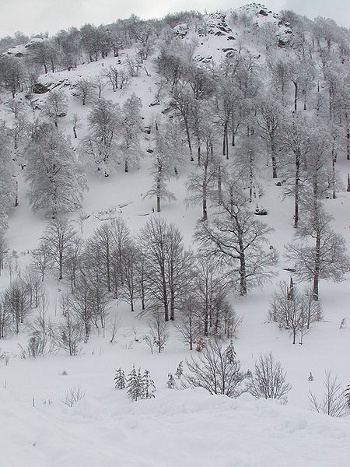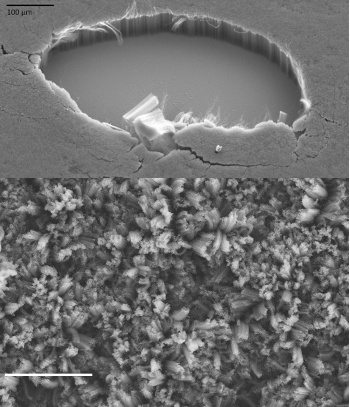Very White and Very Black
November 23, 2011
Many physical quantities need to be
referenced to standards. Such standards were the original mission of the US
National Bureau of Standards, now known as the
National Institute of Standards and Technology.
When
Fahrenheit was devising
his temperature scale, he needed reference points at high and low temperature. His high temperature reference was chosen to be
body temperature, and his low temperature reference was chosen to be the
triple point of water (essentially, 0 °C, or 32 °F).
Fahrenheit would likely have preferred to reference to
absolute zero (-459.67 °F), but that's impossible in principle. Today, we've come to within
100 picoKelvin of absolute zero. That's 10
-10 K. The uppermost temperature is likewise problematic. In theory, it's the
Planck temperature, about 10
32 Kelvin.
The
reflectance of light from an object, more technically the
diffuse reflectivity, is known as its
albedo (from the Latin,
alba, "white."). Standards are not needed for albedo, since it's a ratio, the ratio of reflected to incident light. The albedo of an object will depend on the
wavelength of light; so, something that's
black at visible wavelengths might be
white at other wavelengths.
The albedo of the
Moon is about 0.135. Here, on
Earth, we have a wide range of albedo for objects, ranging from about 0.02 for fresh
asphalt, to about 0.85 for fresh
snow. Pure as the driven snow is still about 15% not so pure. Although the purest white (albedo = 1) and the purest black (albedo =0) are not needed to make an albedo measurement, such objects are technologically useful. For example, an albedo = 1 material would be an excellent roofing material in warmer climates.

"Pure as the driven snow" is actually not that pure.
Snow has an albedo of just 0.85 at visible wavelengths, so 15% of light is absorbed.
That's all for the best, or snow would never melt.
(Via Wikimedia Commons))
Photometric and
radiometric measurements commonly make use of an
integrating sphere, which is a hollow
sphere that's coated on the inside with a material of high diffuse reflectance.
Barium sulfate, which has an albedo of better than 97% at visible wavelengths, is often used in this application.
Teflon (PTFE), with an albedo better than 98% is used, also. These two materials are much whiter than the driven snow.
One the other side of the whiteness spectrum, there's pure black.
Soot, formed in the
smoke of incompletely
combusted hydrocarbons, is also black. An
aerosol particle of soot has a single-scatter albedo at visible wavelengths of 0.226.[1] When soot is applied as a layer to a surface, the albedo is diminished because of multiple scatters. Two scatters reduce the albedo to 0.05, and three scatters will reduce the albedo to about 0.01. This would be an interesting simulation problem. "Consider a
spherical soot particle...;"[2] or, more properly, consider
fractal soot particles.
A technologically useful black material is
black gold, which I wrote about in a
previous article (Black Gold, November 29, 2006). When
gold is evaporated under an
argon or
nitrogen pressure of about 750
millitorr, the gold atoms cool and cluster before attaching to a substrate, forming a black layer.[3-4] The process works for other metals, as well.[5] Black gold has been formed also by irradiating gold with intense bursts of
femtosecond laser light, a process that transforms the surface into a convoluted
nanoscale topography that is optically absorbent.[6]
Anodization is another technique to produce dark surfaces.
Soot, of course, is mostly carbon, so this leads one to wonder how effective
carbon nanotubes can be as a constituent of a super-black material. In 2008, a team of scientists from
Rensselaer Polytechnic Institute, in work sponsored by the
U.S. Department of Energy, created a carbon nanotube material with a lower reflectance than any other material to date. Their super-black, a low-density array of vertically aligned carbon nanotubes, absorbed more than 99.955% of incident light at visible wavelengths. The supposed mechanism is that the nanotube forest has a multitude of holes and gaps to trap light; that is, incident light must make many multiple reflections to exit.[7-8]
In 2009, scientists from the
Japanese National Institute of Advanced Industrial Science and Technology and
Nagoya University prepared a similar array of vertically-aligned carbon nanotubes. They found their material to be an extremely broadband blackbody, absorbing light almost perfectly from 0.2 - 200 μm.[9-10]

Two images of NASA's super-black carbon nanotube composition.
Upper image, with portion removed to show vertical alignment of the nanotubes.
Lower image, a higher resolution image of the surface. The white bar is a 50 μm marker.
Images: Stephanie Getty, NASA Goddard)
The Japanese study used
single-walled carbon nanotubes, but a recent
NASA study looked at the super-black properties of vertically-aligned
multi-walled carbon nanotubes, as shown in the photographs, above. The NASA team prepared these arrays on
stainless steel,
titanium,
silicon and
silicon nitride substrates. The nanotube growth process involves putting a thin
iron layer, which acts as a
catalyst for the nanotube growth process, on such substrates, and then heating them at 750 °C in the presence of carbon feedstock gases.[11]
The NASA material absorbs 99.5% of visible and
ultraviolet light, but only 98% of far-
infrared light. NASA is concerned not only with the optical absorption property, but with the complementary
emissivity. Super-black materials will efficiently
radiate heat energy to keep
spacecraft sensors and
electronic components cool.[11]
References:
- William C. Conant, John H. Seinfeld, Jian Wang, Gregory R. Carmichael, Youhua Tang, Itsushi Uno, Piotr J. Flatau, Krzysztof M. Markowicz and Patricia K. Quinn, "A model for the radiative forcing during ACE-Asia derived from CIRPAS Twin Otter and R/V Ronald H. Brown data and comparison with observations," Journal Of Geophysical Research, vol. 108, no. D23, pp. 29-1 to 29-16; available as a PDF file, here.
- Spherical Cow Page on Wikipedia.
- John Lehman, Evangelos Theocharous, George Eppeldauer and Chris Pannell, "Gold-black coatings for freestanding pyroelectric detectors," Measurement Science and Technology, vol. 14, no. 7 (July, 2003).
- W. Becker, R. Fettig and W. Ruppel, "Optical and electrical properties of black gold layers in the far infrared," Infrared Physics & Technology, vol. 40, no. 6 (December, 1999), pp. 431-445.
- Chih-Ming Wang, Ying-Chung Chen, Maw-Shung Lee and Kun-Jer Chen, "Microstructure and Absorption Property of Silver-Black Coatings," Jap. J. Appl. Phys. vol. 39, Part 1, no. 2A, (February 15, 2000) pp. 551-554.
- Jonathan Sherwood, "Ultra-intense laser blast creates true 'black metal'," University of Rochester Press Release, November 21, 2006.
- Zu-Po Yang, Lijie Ci, James A. Bur, Shawn-Yu Lin and Pulickel M. Ajayan, "Experimental Observation of an Extremely Dark Material Made By a Low-Density Nanotube Array," Nano Lett., vol. 8, no. 2 (February, 2008), pp 446-451.
- Researchers Develop Darkest Man-Made Material, Inside Rensselaer, vol. 2, no. 2, January 31, 2008.
- Kohei Mizuno, Juntaro Ishii, Hideo Kishida, Yuhei Hayamizu, Satoshi Yasuda, Don N. Futaba, Motoo Yumura and Kenji Hata, "A black body absorber from vertically aligned single-walled carbon nanotubes," Proc. Natl. Acad. Sci., vol. 106, no. 15 (April 14, 2009), pp. 6044-6047.
- Brandon Keim, "Scientists Make Blackest Material Ever," Wired, March 31, 2009.
- Lori Keesey and Ed Campion, "NASA Develops Super-Black Material That Absorbs Light Across Multiple Wavelength Bands," NASA Goddard Press Release No. 11-070, November 8, 2011.
Permanent Link to this article
Linked Keywords: Standard; metrology; reference; National Bureau of Standards; National Institute of Standards and Technology; Daniel Gabriel Fahrenheit; Fahrenheit; Fahrenheit temperature scale; body temperature; triple point of water; absolute zero; K; Planck temperature; Kelvin; reflectivity; reflectance of light; diffuse reflectivity; albedo; wavelength; black; white; Moon; Earth; asphalt; snow; pure as the driven snow; Wikimedia Commons; photometric; radiometric; integrating sphere; sphere; barium sulfate; polytetrafluoroethylene; PTFE; Teflon; soot; smoke; combustion; hydrocarbon; aerosol; spherical cow; fractal; black gold; gold; argon; nitrogen; millitorr; femtosecond laser; nanoscale; topography; anodization; carbon nanotube; Rensselaer Polytechnic Institute; U.S. Department of Energy; Japanese National Institute of Advanced Industrial Science and Technology; Nagoya University; single-walled carbon nanotubes; NASA; multi-walled carbon nanotubes; stainless steel; titanium; silicon; silicon nitride; iron; catalyst; ultraviolet; infrared; emissivity; thermal radiation; spacecraft; sensor; electronic component.